This page provides a table compilation of common and uncommon crystals. See also the urinalysis atlas.
Common crystals
| Crystal | pH | Details |
Ammonium biurate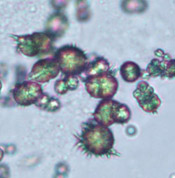 |
Usually acidic to neutral, rarely alkaline: pH ≤ 7 (in humans, usually in alkaline urine) | Variably sized, mostly small to medium, brown, spherical to irregular crystals (“thorny” apple). Common in Dalmatians, English bulldogs. In other breeds of dogs or cats, ammonium crystals suggest liver dysfunction and portosystemic shunting. May occur with amorphous urates or sodium urate (needles or prisms) but uncommonly. Xanthine crystals, which can form after allopurinol treatment, can mimic ammonium biurate crystals (yellow-brown with small projections [Uchiumi and Grindem 2015]), so animals should be checked for this drug treatment. |
Amorphous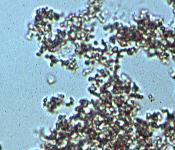 |
Phosphates: pH ≥ 7 Urates: pH ≤ 7 | Small, irregularly shaped crystals. Can be of different composition (urates, xanthine, phosphate) depending on pH. Can be seen in healthy animals. Mimic bacterial cocci – perform a gram stain or regular cytology smear to differentiate. (there is another cause in Thelma, i.e. chronic-active metritis/pyometra) material from degrading cells can mimic these crystals. |
Bilirubin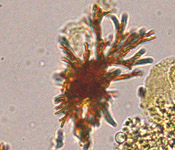 |
Acidic: pH < 7 | Variably sized (usually small) needle-like to granular yellow or yellow-brown crystals. Indicates bilirubinuria due to conjugated (direct) bilirubin. Bilirubinuria can be normal in dogs (to some degree) but is abnormal in other species. |
Calcium carbonate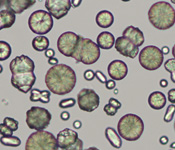 |
Usually alkaline: pH ≥ 7 | Variably sized, with the circular variants typically being medium to large, spherical to irregular (rhomboid, dumb-bell, ovoid) yellow to colorless crystals. Spherical forms have radial striations. Normal in horses, guinea pigs. Not normally seen in dogs, cats or ruminants. |
Calcium oxalate dihydrate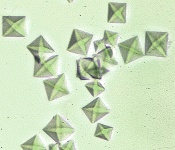 |
Usually neutral to acidic: pH ≤ 7 | Mostly small, but can be large. Colorless octahedrons, “envelopes”. Can be seen in healthy animals or in animals with calcium oxalate uroliths. Can also be seen with hypercalciuria or hyperoxaluria (eg. ethylene glycol or oxalate rich plant ingestion). Develop over time with storage of urine. |
Magnesium ammonium phosphate (struvite)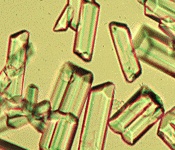 |
Usually neutral to alkaline: pH ≥ 7 | Usually large.Can be seen in healthy dogs, cats and ruminants. Also common in bacterial-induced alkalinuria and with sterile struvite or mixed uroliths. |
Uncommon crystals
| Crystal | pH | Details |
Uric acid |
Acidic: pH < 7 | Variably sized, small to medium, with some large forms. Yellow, red-brown or brown, rarely colorless.Variable in shape: Rhomboid to diamond crystals, often with pointed ends, hexagonal flat crystals, rosettes, barrel shapes, needles (uncommon) |
Calcium oxalate monohydrate 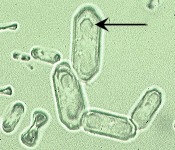 |
Usually neutral or acidic: pH ≤ 7 | Mostly medium to small. Oval, spindle, dumb-bell and picket fence-shaped forms. Oval, spindle or dumb-bell forms are infrequently seen in urine from healthy dogs and cats and more commonly seen in urine from horses (not related to disease). They can also be seen in hypercalciuric conditions and ethylene glycol toxicity. Picket fence forms (arrow) are not seen in healthy animals but can be observed in the urine of dogs and cats with ethylene glycol toxicity. They can also be seen in animals with hypercalciuria due to other causes (e.g. lymphoma). Animals with ethylene glycol toxicity can also have the other variants of calcium oxalate monohydrate. |
Calcium phosphate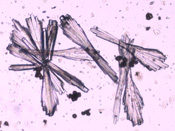 |
Usually neutral or alkaline: pH ≥ 7 | Medium to small, Colorless. Blunt-ended needles or prisms, often in rosettes, can be amorphous |
Cystine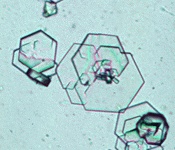 |
Usually neutral to acidic: pH ≤ 7 | Variably sized, mostly medium. Flat colorless hexagonal plates, which often aggregates.Indicative of cystinuria, a rare inborn error of amino acid metabolism affecting many breeds of dogs. |
Drug-associated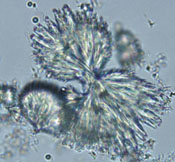 |
Variable but usually acidic: pH < 7 | Various forms (needles, radiating bundles, round with striations) and sizes (small to large), yellow to colorlessCan be seen in animals on certain drugs: e.g. sulfonamides (mimic various forms of urates), ampicillin (slender needles to sheaves), contrast media, primidone.The image on the left is a sulfonamide crystal (often forms fan-shaped structures) from a dog that was treated with trimethoprim-sulfonamide and sulfasalazine for a chronic urinary tract infection |
Tyrosine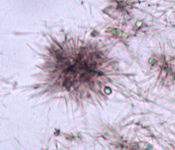 |
Acidic: pH < 7 | Small crystals (appear large because they are in aggregates). Fine colorless to brownish needles.Indicate severe liver disease or conditions causing aminoaciduria in humans, but very rare in animals |
Unknown crystals: (i) needles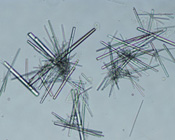 (ii) needle-like bundles (ii) needle-like bundles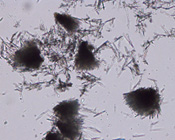 (iii) flat plates resembling cholesterol (iii) flat plates resembling cholesterol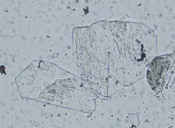 |
Variable pH | All the crystals shown on the left were seen in the urine from dogs. Their identity is uncertain. Variable shape. Solubility assessed with hydrochloric acid, acetic acid and sodium hydroxide – solubility characteristics do not match those of known crystals. Significance dependent on clinical signs and history. |
